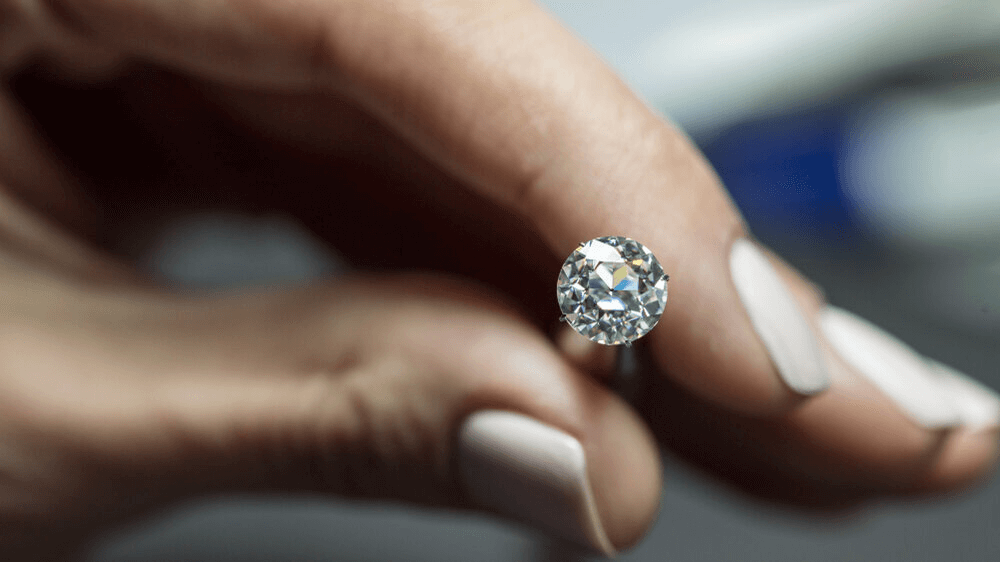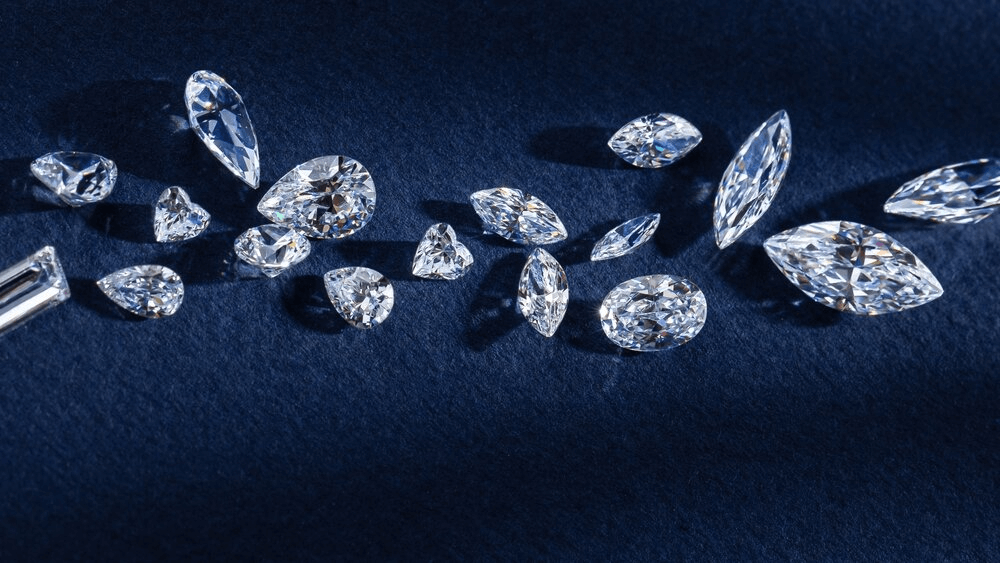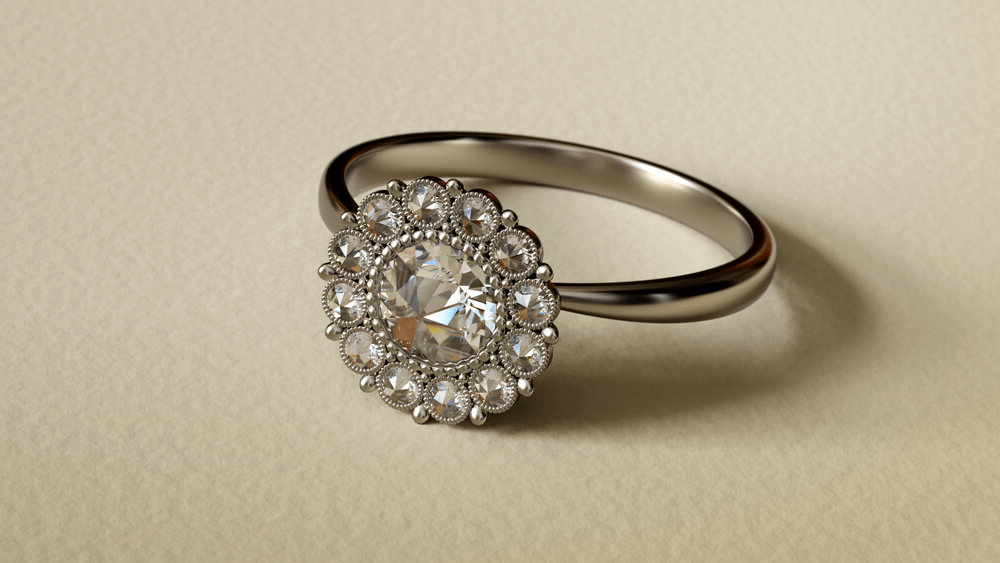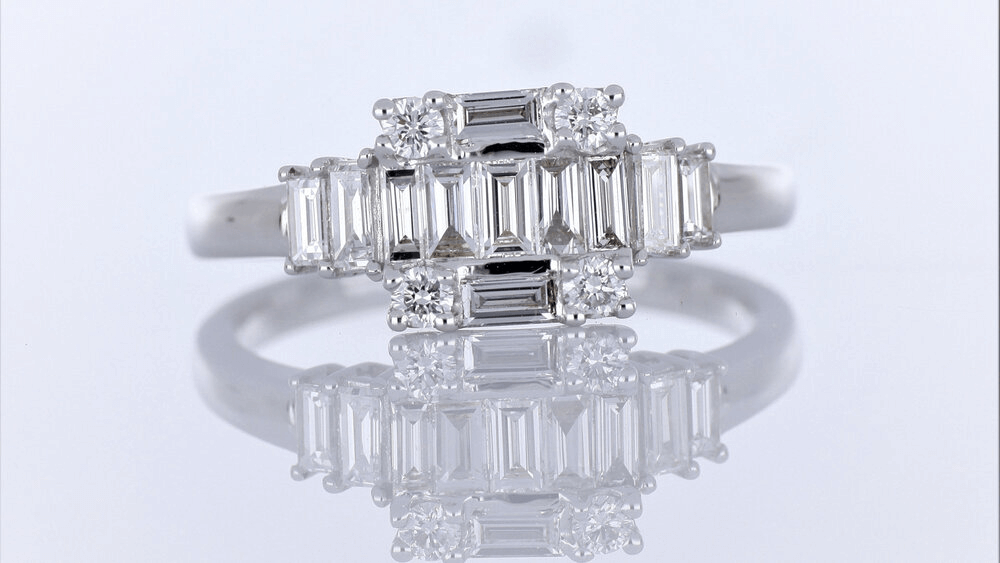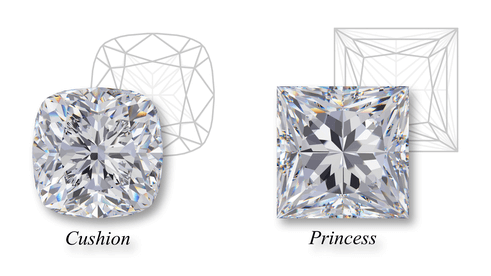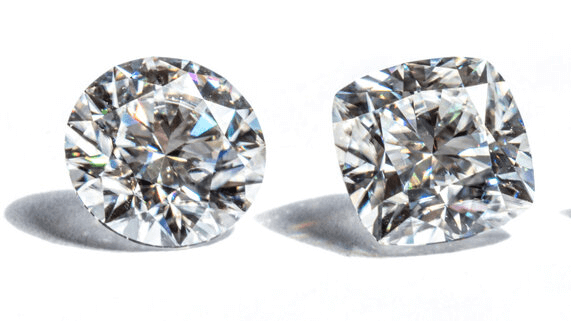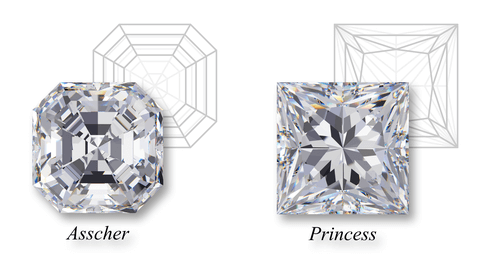Asscher Cut Diamonds: A Fascinating Royal History

By Gary A.

Edited by Olivia H.
Published May 11, 2021
Edited on Dec 17, 2024
With their striking geometric elegance, Asscher cut diamonds bring a timeless, vintage allure to engagement rings that is both sophisticated and utterly captivating.

- 7 Quick Tips for Buying an Asscher Cut Diamond Engagement Ring
- Introduction
- Overview of the Asscher Cut Diamond
- Asscher Cut vs Emerald Cut
- Historical Significance of Asscher Cuts
- Asscher Cut Cost Considerations
- Choosing an Asscher Cut Diamond
- Our Expert Take
- 10 FAQs
Before we dive deeper into the specifics, here are some practical tips to help guide your decision-making process:
7 Quick Tips for Buying an Asscher Cut Diamond Engagement Ring
- Tip 1: Understanding the Unique Characteristics of Asscher Cut: Recognize the Hall of Mirrors: Asscher cuts are known for their deep, step facets which create a distinctive “Hall of Mirrors” effect. This feature is a hallmark of quality in Asscher cut diamonds. Square Shape with Cropped Corners: The Asscher cut is essentially square but with cropped corners, giving it a somewhat octagonal appearance. Ensure the cut is symmetrical and the cropped corners are uniform.
- Tip 2: Prioritizing Clarity and Color Emphasize Clarity: Due to their large open tables, Asscher cut diamonds reveal inclusions more readily than other cuts. Aim for a clarity grade of at least VS2 to ensure the inclusions are not easily visible. Consider Color Grades Carefully: The step facets of an Asscher cut can make color more apparent. It’s advisable to opt for a higher color grade, particularly if the diamond is larger than 1.5 carats.
- Tip 3: Size and Proportions Matter Assess the Length-to-Width Ratio: For a classic Asscher look, the length-to-width ratio should be close to 1:1. This proportion ensures the diamond maintains its characteristic square shape. Be Mindful of Carat vs. Size Perception: Asscher cuts often appear smaller than other shapes of the same carat due to their depth. Consider a slightly higher carat weight to compensate for this visual difference.
- Tip 4: Choosing the Right Setting Opt for a Protective Setting: Given the Asscher cut’s cropped corners, choose a setting that protects these points. A four-prong setting is typically recommended to secure and highlight the diamond effectively. Complement with the Right Band: Asscher cut diamonds pair well with simpler bands to emphasize their geometric beauty. A pave or channel-set band can add sparkle without overshadowing the main stone.
- Tip 5: Balancing Budget with Preferences Budget for Higher Clarity and Color: Allocate a larger portion of your budget towards securing a diamond with higher clarity and color grades, as these aspects significantly impact the appearance of an Asscher cut. Consider the Overall Impact: An Asscher cut diamond’s appeal lies in its vintage charm and architectural lines. Choose a diamond that speaks to these qualities while fitting within your budget.
- Tip 6: Scrutinize the Diamond Under Different Lighting Conditions Observe Light Performance: Examine how the diamond interacts with light. Asscher cuts have a unique way of reflecting light due to their step cuts, so it’s important to view them under various lighting to appreciate their true beauty.
- Tip 7: Factor in the Diamond’s Historical and Artistic Value Appreciate the Heritage: An Asscher cut diamond is not just a piece of jewelry but a fragment of history. Its design is deeply rooted in the Art Deco movement, making it a timeless choice for those who value both aesthetics and historical significance.
Now that you’ve got these practical tips, use Jeweler AI below to find the perfect engagement ring that suits your style and budget:
Introduction
In spite of the undeniable popularity of the brilliant cuts – and, of course, their exceptional sparkle – there is no avoiding the fact that the step cuts boast their own, unique allure.
They represent a subtler, more understated way of showcasing the beauty of diamond. Their seemingly endless, geometric depths create an incredibly sophisticated centerpiece for any engagement ring, and prove that maximum sparkle is not quite everything when it comes to finding a beautiful diamond.
This is why the Asscher cut has grown so popular since its creation more than a century ago – and why you should definitely consider adding it to your list of contenders.
Overview of the Asscher Cut Diamond
The Asscher is a step cut diamond featuring a square shape with beveled corners, known for its elegance and glassy shine.
An Asscher cut diamond is a square with a length-to-width ratio of 1.00, and the angular, beveled corners you will likely recognize from the Emerald cut.
The Hall of Mirrors Effect
The cut features large step facets and a high crown that results in stunning brilliance, creating the optical illusion known as the “Hall of Mirrors” effect that draws so many of us toward the step cuts.
A well-cut Asscher diamond will appear to have concentric squares as you look down through the table, resulting from the proper positioning of the pavilion facets underneath.
Asscher Cut vs Emerald Cut
While the cut does resemble an Emerald cut, there is a key difference. The Asscher achieves that hall of mirrors effect in the square form instead of a rectangle. However, Square Emerald cuts do exist…
The two cuts are so similar, however, that the Asscher cut is often times referred to as a Square Emerald cut on a diamond certification, such as those issued by the GIA. It might bring about some confusion to the name of the cut, but the Asscher and Square Emerald cuts are actually the same.
The rare, Royal Asscher cut, which is a patented version of the original Asscher cut, is still offered by the GIA.
Switching from square to rectangular not only impacts the appearance of both diamonds when they are placed within their settings – the Emerald can have a lengthening effect on the finger, while the width of the Asscher can make the finger appear slimmer – but it also means that the Asscher (or Square Emerald) appears larger than a rectangular Emerald cut of the same size.
The Unique Brilliance of Asscher Cuts
Yes, but not in the same way as the Round cut, or the modified brilliants like the Oval, Princess, Cushion or Marquise.
It seems fair to say that the most striking difference between the Asscher cut and the Round cut is the way their facets are arranged. While the Round features many smaller, pyramid-shaped facets across the crown and pavilion, the facets found on the Asscher are longer and run parallel to the edges of the stone.
But what does this have to do with sparkle? A lot, in fact. Those smaller, more intricately placed facets found on the Round cut are responsible for the incredibly high levels of fire, brilliance, and scintillation you find in so many diamond shapes.
The elongated facets on the Asscher, however, tell a totally different story. Asscher diamonds create plenty of fire and brilliance, but the effect is calmer – a little more subdued – but still very beautiful.
Historical Significance of Asscher Cuts
The Asscher cut diamond was first produced in 1902 and named after Joseph Asscher in Amsterdam, Holland. The Asscher brothers were known for being commissioned by King Edward VII for cutting the world’s largest stone, the Cullinan, at 3,106 carats, before it was placed in the English crown jewels.
From there, the Asscher cut gained popularity in the 1920’s, but lost momentum and was only found in antique shops – a symbol of a bygone era of glamour. It wasn’t until about 100 years later, in 2002, that the cut began to make a comeback, with new cut modifications, giving the cut more brilliance than the original Asscher cut diamond.
Elizabeth Taylor put the Asscher cut back in the spotlight with her infamous Krupp diamond, a gift from Richard Burton. It is one of the most famous diamonds in the world, and now known as the Elizabeth Taylor Diamond. Today, many celebrities also adorn Asscher cut diamonds on their fingers.
Asscher Cut Cost Considerations
Two diamonds with the same grades for cut, clarity and color – and the same carat weight – will, in all likelihood, differ significantly in price, with the Round costing much more than the Asscher.
Nevertheless, Round diamonds are better at hiding mild inclusions than Asscher and Square Emerald diamonds, since step cut facets draw the eye deeper into the diamond. As a result, while you might find that an eye clean Round diamond is available at your desired carat weight with a more affordable clarity grade of, say, SI1, the different structure of the Asscher may mean you need to pay more for a higher clarity grade.
The Popularity of Asscher Cuts
Their chic, Art Deco style has taken pride of place in many engagement rings over the decades.
Of course, this cut isn’t able to rival the Round and Oval in terms of sheer popularity but, for many years now, the Asscher cut’s ability to draw the eye into its seemingly unending depths has ensured it a high spot on the list of top diamond shapes out there. As such, there’s no denying that the Asscher will continue to represent a classic choice for many generations to come.
What the Asscher Cut Says About You
Those who choose the Asscher tend to have a pretty timeless taste in fine jewelry – one that would look just as at home in the glittering halls of the roaring 20s as it would at an elegant cocktail party today.
While the wearer of the Asscher is quite happy to sacrifice some of the brilliance and fire offered by the Round and modified brilliant cuts, their appreciation for the innate beauty of diamond – and of the skilled work of the cutter – shines brightly regardless.
What is Special About Asscher Cut Diamond?
From its mesmerizing shine to its timeless look and versatility, the Asscher has a lot going in its favor.
Not only is the Asscher cut highly sophisticated and flattering, but it also boasts a unique and fascinating history among Royalty, and Hollywood’s very own Queen, too…
Choosing an Asscher Cut Diamond
The Asscher cut was designed to draw the eye into the diamond, so when choosing an asscher cut, you should always select the highest quality stone to retain its brilliance.
Asscher Cut Diamond Cut Guide – (Square Emerald)
The cut attributes of a diamond contribute to its sparkle and beauty. The most knowledgeable buyers would choose attributes from the Excellent – Very Good columns.
| Excellent | Very Good | Good | Fair | Poor | |
| Table % | 60 – 65.9 | 58 – 59.9 or 66 – 69.9 | 56 – 57.9 or 70 – 71.9 | 54 – 55.9 or 72 – 73.9 | <53.9 or >74 |
| Depth % | 63 – 67.9 | 58 – 62.9 or 68 – 69.9 | 56 – 57.9 or 70 – 70.9 | 54 – 55.9 or 71 – 73.9 | <53.9 or 74 |
| Girdle | Very Thin to Slightly Thick | Very Thin or Thick | Very Thin or Very Thick | Extremely Thin or Extremely Thick | |
| Culet | None | Very Small | Small | Medium | >Medium |
Asscher Cut Diamond Length-to-Width Guide
A classic Asscher cut has a length-to-width ratio of 1.00.
| Excellent | Very Good | Good | Fair | Poor | |
| Square | 1.00 – 1.029 | 1.03 – 1.05 | 1.06 – 1.08 | >1.08 | |
Asscher Cut Diamond Symmetry, Polish, Cut and Fluorescence Guide (Square Emerald)
Our experience suggests that Cut, Symmetry, Polish, and Fluorescence contribute to a diamond’s brilliance, so most buyers will choose Excellent – Very Good and Fluorescence None – Faint.
| Excellent | Very Good | Good | Fair | Poor | |
| Cut | Excellent | Very Good | Good | Fair – Poor | |
| Polish | Excellent | Very Good | Good | Fair – Poor | |
| Symmetry | Excellent | Very Good | Good | Fair – Poor | |
| Fluorescence | None | Faint | Medium | Strong –Very Strong |
Asscher Cut Diamond Color Guide (Square Emerald)
Most buyers prefer size over color hue and will buy a diamond of G color.
| Excellent | Very Good | Good | Fair | Poor | |
| < 0.50 ct. | D – G | H – I | J – K | L – M | > N |
| 0.51 – 1.00 ct. | D – F | G – H | I – J | K | > L |
| 1.00 – 2.00 ct. | D – F | G – H | I – J | K | > J |
| >2.00 ct. | D – F | G – H | I – J | K | > J |
Asscher Cut Diamond Clarity Guide (Square Emerald)
As always, finding an eye clean diamond is very important, so most shoppers will buy a diamond of VS1 – VS2 Clarity.
| Excellent | Very Good | Good | Fair | Poor | |
| < 0.50 ct. | FL – VS2 | SI1 – SI2 | I1 – I2 | > I2 | |
| 0.51 – 1.00 ct. | FL – VS1 | VS2 | SI1 – SI2 | I1 – I2 | > I2 |
| 1.00 – 2.00 ct. | FL – VVS2 | VS1 – VS2 | SI1 – SI2 | I1 | > I1 |
| >2.00 ct. | FL – VVS2 | VS1 – VS2 | SI1 – SI2 | I1 | > I1 |
Asscher Cut Engagement Ring: the Best Setting for Asscher Cut Diamonds
Asscher cut diamonds require four-pronged settings due to the shape of the cut. Because of the stunning Art Deco style of the cut, an asscher diamond looks incredible in a vintage ring setting or a halo setting to add extra sparkle to the stone.
The Asscher can look sleek and modern in a bezel setting, too, although this will prevent as much light from entering the diamond and impact its light performance as a result.
As always, a strong grade across the Four Cs is essential to choosing a beautiful Asscher cut diamond.
Our Expert Take
The Asscher is a beautiful, unique, and historic cut with a lot of potential for creating some truly stunning engagement rings. The most important thing to keep in mind is the fact that it won’t sparkle like a round or modified brilliant – the shine is more refined, and creates that dazzling hall of mirrors effect. Remember the importance of a high quality cut and polish, and of an eye clean diamond, since the table is pretty open.
10 FAQs
- Q: What Makes an Asscher Cut Diamond Unique?
- A: An Asscher cut diamond is renowned for its deep step cuts and high crown, which create a distinctive “Hall of Mirrors” effect. It’s a square cut with cropped corners, giving it a unique, almost octagonal appearance.
- Q: How Does an Asscher Cut Compare to an Emerald Cut?
- A: While both are step cuts, the Asscher cut is square with cropped corners, whereas the Emerald cut is rectangular. The Asscher cut typically offers more brilliance due to its higher crown and deeper pavilion.
- Q: Is Clarity More Important in Asscher Cut Diamonds?
- A: Yes, clarity is crucial for Asscher cuts because their large, open facets make inclusions more visible. It’s recommended to choose a diamond with at least a VS2 clarity grade. What Color Grade
- Q: Should I Choose for an Asscher Cut Diamond?
- A: Higher color grades are preferable for Asscher cuts, especially for larger stones, as the step facets can make color more noticeable. Aim for a color grade of at least H or I for a good balance of color and value.
- Q: Do Asscher Cut Diamonds Appear Larger or Smaller?
- A: Asscher cut diamonds often appear smaller than other shapes of the same carat weight due to their deep pavilion and high crown. You might consider a slightly larger carat size for a more impactful appearance.
- Q: What is the Best Setting for an Asscher Cut Diamond?
- A: A four-prong setting is ideal as it secures the diamond while protecting its cropped corners. Asscher cuts also look stunning in vintage-inspired settings or simple solitaires that highlight their geometric form.
- Q: How Does the Asscher Cut’s Price Compare to Other Cuts?
- A: Asscher cut diamonds can be more affordable than round brilliants but may be priced higher than some fancy shapes. The cost is influenced by factors like clarity, color, and overall demand for the cut.
- Q: Can I Find an Asscher Cut in a Halo Setting?
- A: Yes, Asscher cut diamonds can be set in a halo setting. The halo of smaller diamonds accentuates the Asscher cut’s vintage appeal and adds extra brilliance.
- Q: How Do I Ensure I’m Buying a High-Quality Asscher Cut Diamond?
- A: Look for a well-proportioned cut with a length-to-width ratio close to 1:1, high clarity, and a desirable color grade. Also, consider purchasing from reputable jewelers and requesting certification from recognized gemological institutes.
- Q: Are Asscher Cut Diamonds Good for Engagement Rings?
- A: Absolutely. Asscher cut diamonds are perfect for engagement rings, offering a unique, vintage elegance and sophisticated charm that appeals to those who appreciate classic, architectural designs.
Explore the world of Asscher cut diamonds with Jeweler AI and find the perfect symbol of your enduring love.
FOLLOW-UP GUIDE SERIES

